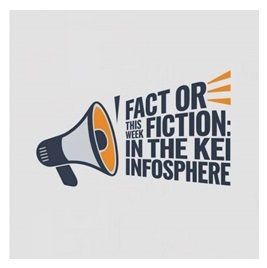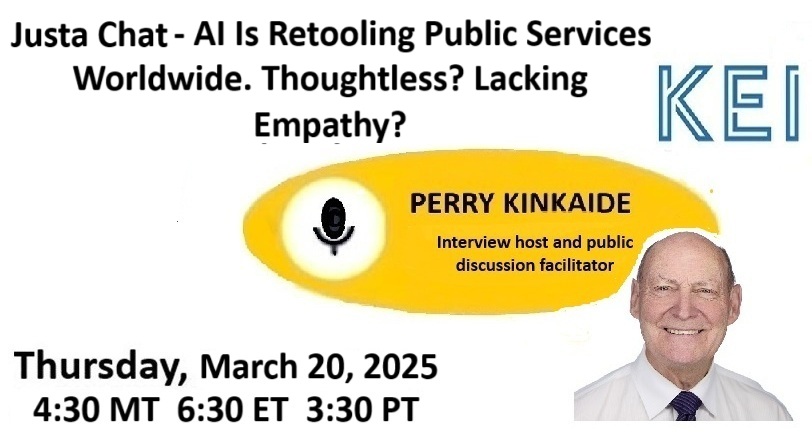|
Obesity - A widespread societal problem |
DIRECTORY | ||
|
Contributions: |
Action: Help sustain KEI's contributions |
Fact or Fiction?
Alberta energy was understated? |
|
|
Editor - Perry Kinkaide |
Change is necessary but rarely popular. Leaders of change face resistance, often requiring external change agents to enforce tough decisions. Their role isn’t to be liked but to ensure transformation succeeds. When faced by a crisis, the end - retooling the public service wiht AI, may justify the means - slashing without empathy. To understand why, consider:
John F. Kennedy, “There are risks and costs to action. But they are far less than the long-range risks of comfortable inaction.” And as expressed by Elon Musk, "The fundamental weakness of Western Civilization is empathy".
Also, Canada's new liberal candidate for Prime Minister - Mark Carey, is making Europe his first trip when he should have visited Alberta - now an understated world energy super-power. - Editor |
||
|
AI Is Retooling Public Services. Thoughtless? Lacking Empathy?
The rapidly accelerating deployment of artificial intelligence across the public sector has been getting a lot of media attention since Elon Musk’s DOGE initiative in the United States really started rolling. What’s getting more attention now is the impact on government employees amid fears that the government will function less, and not more, effectively, as a result. As AI systems are rapidly rolled out, a picture emerges of opportunity, anxiety, and potential unintended consequences that could reshape the very nature of public service.
The Pace of Change. The transformation is happening early in the new President's term, and at breakneck speed to get the pain overwith before mid-term elections. According to Oxford Economics estimates, as many as 200,000 federal jobs could be eliminated in 2025 in the US alone. The Atlantic reports that "tens of thousands of federal workers have resigned or been terminated" as part of broader government efficiency initiatives led by the Department of Government Efficiency (DOGE).
This isn't just a US phenomenon. In the UK, Labour Party Prime Minister Keir Starmer has announced that "AI should replace the work of government officials where it can be done to the same standard," with officials told to abide by a new mantra: "No person's substantive time should be spent on a task where digital or AI can do it better, quicker and to the same high quality and standard." The UK government claims this digital revolution could bring £45 billion in savings. - continued below
No registration necessary. Just check in https://us02web.zoom.us/j/84258596166?pw.. Continued from above. Meanwhile, Canada has adopted a more measured approach. In March 2025, the Canadian government launched its first AI Strategy for the federal public service, focusing on establishing an AI Centre of Expertise, ensuring responsible AI use, providing training, and building public trust. This follows a C$2.4 billion investment package announced in April 2024 to support the AI sector, with C$2 billion dedicated to AI infrastructure and business development. Across the European Union, member states are pursuing varied approaches: Spain has established the €5 million Artificial Intelligence Supervisory Agency for oversight of AI systems; France supports public administrations through its cross-sector "Lab IA" and specific remuneration for AI experts; while Italy has integrated AI into its "Three-Year Plan for the Digitalization of the Public Sector (2024-2026)".
In China, the approach has been different still - characterized by rapid, widespread adoption of homegrown AI models like DeepSeek across sectors. Government agencies have been quick to integrate this technology, with the southern tech hub of Shenzhen reporting "great improvement in efficiency" after adopting DeepSeek in a system used by 20,000 government workers. Local officials claim the AI-written documents have achieved a 95% accuracy rate, with a 90% reduction in administrative approval times.
Who Stays, Who Goes: The Talent Paradox. Betterworks' 2025 State of Performance Enablement report reveals a troubling pattern that could undermine the very efficiencies these initiatives seek to create:
This pattern reflects what I described as one of the risks of government-wide voluntary resignation programs - they'll be seized upon by two groups - the long term employees who are close to retirement anyway, and the best and the brightest who have initiative and lots of other opportunities - the risk is in losing an organization's best and brightest and simultaneously accelerating the departure of senior people who hold a lot of organizational knowledge and history between their ears.
Are these cuts about increasing efficiency or disabling the administrative/ regulatory state? Musk’s efforts raise alarms – cutting Federal Aviation Administration employees with a role in regulating SpaceX, cutting U.S. Securities and Exchange Commission employees with a role in investigating his businesses, and removing oversight from National Transportation Safety Board regarding Tesla’s Full Self Driving software makes me, and many others, wonder about his motives.
A Widening AI Divide. The human impact of AI's uneven adoption is stark. The Betterworks report shows that while 87% of daily AI users report improved productivity, adoption varies dramatically across organizational levels:
This divide creates a two-tier workforce where those with access to AI tools surge ahead while others fall behind. As one union leader in the UK noted, "Civil servants are not hostile to reforms, but these must be undertaken in partnership with staff and unions."
Anxiety in the Age of AI. Perhaps most revealing is what the Betterworks report calls the "paradox of AI optimism" - employees who are most familiar with AI also report the highest anxiety about its impact:
This anxiety appears warranted given explicit government plans. The Atlantic reports that in the U.S., AI is being considered to "help determine whether employees across the government should keep their job," and one division expects to be "at least 50 percent smaller" within weeks.
At the US Government's General Services Administration (GSA) agency, a chatbot initially designed as an experimental "Sandbox" by the Biden Administration, is being fast-tracked for deployment to over 10,000 workers responsible for more than $100 billion in contracts and services. Thomas Shedd, a director at GSA's IT division, envisions using "coding agents" to replace human programmers and automated systems to analyze contracts and perform finance functions.
Four Paths to Government AI: Contrasting Visions. The global landscape reveals four distinct approaches to AI implementation in government, each with different implications for employees:
The US approach is characterized by rapid deployment and workforce reduction. At the Department of Government Efficiency, the emphasis is on speed and cutting headcount, with The Atlantic reporting that AI tools are being rolled out "seemingly without much regard for which applications of the technology may be feasible."
The UK's model emphasizes similar efficiency goals but has prompted union warnings about employee morale "after years of being demonized as unproductive." Dave Penman of the Food and Drug Administration's union cautioned that "mantras that look like they've been written by ChatGPT are fine for setting out a mission, but spending rounds are about reality."
Canada's strategy presents a more deliberate approach, emphasizing responsible implementation through its AI Centre of Expertise. By focusing on building public trust alongside efficiency gains, the Canadian approach acknowledges that AI implementation requires cultural adaptation alongside technological deployment.
The EU framework balances innovation with regulation. Spain's Agency for the Supervision of Artificial Intelligence, France's "Lab IA"; and Italy's three-year digitalization plan exemplify a distinctly European approach: integrating AI into public service while establishing oversight mechanisms and specific workforce development strategies. The focus on remuneration for AI experts in France suggests recognition that retaining specialized talent requires competitive compensation.
China's implementation reflects yet another model - patriotic adoption. Nearly 100 Chinese hospitals and countless government agencies have rapidly integrated DeepSeek, a homegrown AI model. As one analyst noted, Chinese institutions are adopting DeepSeek "not only to improve their services but to also signal their support for the government's goals." The approach emphasizes practical applications over model development, with a technology analyst explaining: "The government, companies, and investors in China share a common belief that China's AI opportunity lies more in AI applications - services built on top of AI - rather than solely trying to make models larger."
Perry commented that "AI could be like Ozempic for the organizations”. It’s an analogy worth exploring. AI could offer transformative benefits by reducing inefficiencies, curbing “hunger" for excess resources, and creating a sense of "satisfaction" through faster, more personalized service delivery. Just as Ozempic helps optimize the body's energy use, AI could streamline operations, improve decision-making, and enhance productivity in public administration. However, like Ozempic, AI comes with "side effects"; that have to be managed carefully. These include initial discomfort as systems adapt, potential biases in algorithms ("digestive issues"), resistance to change from staff ("headaches"), and concerns about privacy and data security ("allergic reactions"). Additionally, over-reliance on AI could lead to a loss of the human touch in services ("vitamin deficiency"), and its long-term societal impacts remain uncertain. To fully realize AI's potential, it must be implemented thoughtfully, with safeguards to address these challenges while maximizing its benefits.
The point is that these tools can be deployed effectively to synthesize information and reach preliminary conclusions about how and where to address excesses. But like Ozempic, they are Band-Aids; tools in the toolbox and not solutions in and of themselves. Without further diagnosis and the hard work required of deep fixes like systemic change and actual culture shift (that takes years), they won’t produce lasting change. But that’s just my opinion and perhaps I’m too set in my ways and too oblivious to the need to break things down before we can build them back up.
My skepticism extends to the U.S. government’s current implementation approach. If Elon wants to "move fast and break things"... he can be successful in the short run at reducing headcount and cutting costs. But some of the DOGE strategies have been ham-handed and dumb - firing probationary employees is easier but it disproportionately affects younger and more tech-savvy employees - the very employees that modern government service needs.
What Employees Want. Despite the anxiety, the Betterworks report reveals that employees aren't opposed to AI - they simply want it implemented thoughtfully:
In the UK, unions echo this sentiment. Dave Penman noted that "civil servants will welcome the commitment of more support with digital transformation, "but the government "needs to set out, in detail, how more can be delivered with less."
Moving Forward Responsibly. The current approaches to government transformation around the world offer a natural experiment in AI implementation strategies, with implications for both public sector workers and the citizens they serve. As AI systems are deployed at varying speeds and scales, government agencies face critical questions:
1. Who benefits? Will AI tools be equitably distributed, or will they widen existing divides between leadership and front-line workers? The contrasting approaches - from the US's aggressive cuts to Canada's emphasis on responsible use to China's patriotic adoption - will teach us valuable lessons about both technical implementation and human impacts. But as this transformation unfolds across countries, the human cost remains the most uncertain factor. The technology may be ready (or almost ready), but are the organizations and people within them ready for such rapid change? The gulf between tech optimism and on-the-ground implementation realities suggests to me that we should proceed with both enthusiasm, some element of empathy, and caution.
We need to focus on AI as a complement to human capabilities rather than a wholesale replacement for the people who have dedicated their careers to public service. I fear that the rush to accelerate adoption of AI systems across the U.S. government is being driven by unrealistic and as yet unproven confidence in these tools to deliver accurate and reliable results. Furthermore, the architect of this push was recently quoted as saying “The fundamental weakness of Western civilization is empathy”. That perspective should give pause to everyone concerned about effective and lasting organizational change. KEInetwork.net |




